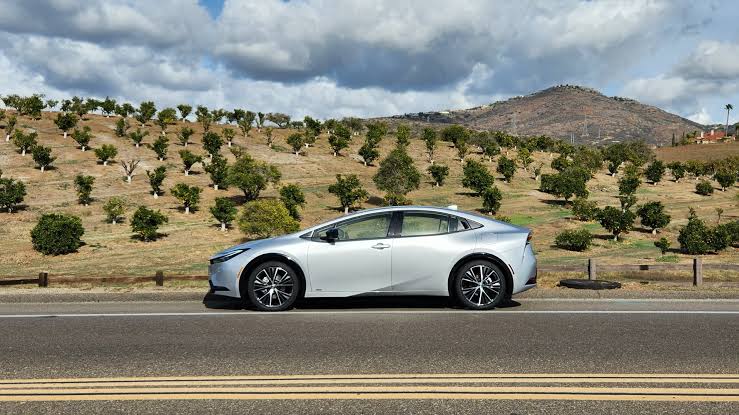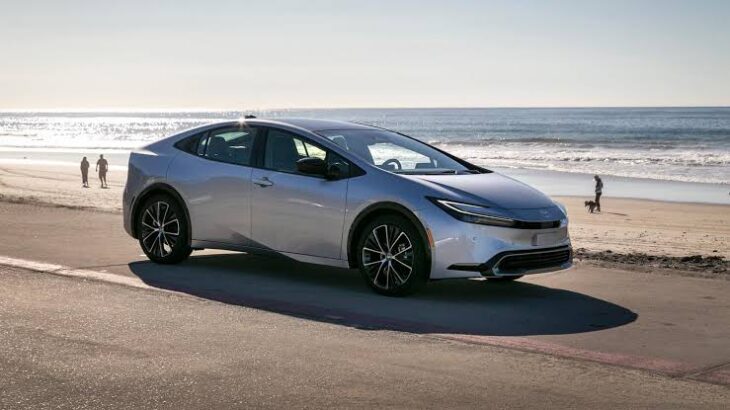As it transitions into its 5th generation in 2023, the Toyota Prius hatchback “turns over a new leaf”—yes, that’s a smart allusion to Nissan’s electric vehicle. The Prius, formerly arguably the ugliest automobile on the road, has transformed into a stunning butterfly. The new vehicle has the most horsepower a Prius has ever produced, up to 196. The 194-hp front-wheel-drive vehicle is expected to attain a combined fuel economy of up to 57 mpg, which is also a Prius record. A newly renovated interior embraces a more conventional arrangement for the driver’s space, with larger screens and an improved feature selection that includes heated back seats as an option.
The low roofline, wide stance, and low seating position of the new Prius complete its transformation into a vehicle that appears to be well worth driving. The Toyota that spearheaded the hybrid revolution now faces competition from a wide range of vehicles, including the Hyundai Elantra Hybrid, Toyota’s own Corolla Hybrid, and a number of hybrid SUVs.

A completely renovated and redesigned fifth generation of the Toyota Prius debuts in 2023. Each and every Prius now rides on the most recent iteration of Toyota’s TNGA-C platform, which gives it a leaner, more rigid, wider stance, and lower driving position. With the inclusion of a new 194-hp hybrid powertrain with an all-wheel drive option, the Prius is now faster than many other hybrid competitors while maintaining the same level of fuel efficiency. All-wheel-drive variants have an additional high-output magnet within the rear motor, which gives them 196 horsepower. There is also a 220-hp plug-in hybrid Prius Prime variant available, but we don’t review it here.
The Toyota Prius, which is renowned for its outstanding fuel efficiency, lives up to its green promise. It has a solid array of safety features and extras, just like how reluctant it is to stop for petrol. The beginning price of the base models isn’t too ridiculous and they have 17-inch wheels, blind-spot monitoring, and rear cross-traffic warning.
The Toyota Prius lineup only offers one powerplant. This hybrid system, which produces 194 horsepower, is made up of a continuously variable automatic transmission and a 2.0-liter hybrid inline-four gasoline engine that was taken from the Corolla Cross hybrid crossover. Drive is always from the front. Toyota boosts the total powertrain output of its all-wheel-drive Priuses to 196 horsepower, a 60 percent increase in power, by adding a high-output permanent magnet electric motor to the rear axle.

So according our testing of the front-wheel-drive Limited model, the Prius now accelerates to 60 mph in just 7.1 seconds as opposed to the tiring 10.5 seconds it took last year. That is faster than both the Camry and Elantra hybrid models combined. The new Prius stops from 70 mph quicker than its previous version as well; it does it in just 171 feet as opposed to 194 feet from a prior test. This is due to bigger front and rear brakes.
In spite of having a bigger engine and a more potent drivetrain, the Toyota Prius will get higher fuel efficiency in 2023. For the front-wheel drive variant, the EPA estimates that the Prius gets 57 mpg in the city and 56 mpg on the highway. That is an increase of 4 and 6 mpg over the previous generation. Fuel economy for all-wheel-drive Prius models is predicted to be 53 mpg in the city and 54 mpg on the highway. When we have statistics for the Prius from our 75 mph highway fuel efficiency test, we’ll update this section.
While the exterior of the new fifth-generation Prius has changed, the interior has stayed more traditional, with a more conventional auto cockpit now present. A gauge cluster is now located immediately behind the steering wheel for the first time in the Prius. The interior of the vehicle is altered by the new design, which has a roofline that is 2.0 inches lower and front passengers who sit lower due to a lower centre of gravity. The imitation leather steering wheel that comes standard on base models can be upgraded to heated front seats, additional cup holders for the backseat passengers, and heated rear seats by choosing the XLE or above trim level.
The screens on both base and higher-level versions are larger than those on the outgoing vehicle. In the LE and XLE, a new 8.0-inch infotainment screen is now standard, and Toyota has upgraded the Limited’s screen to a mammoth 12.3 inches (or as optional equipment for the XLE). With the help of over-the-air updates, this system upgrades its infotainment through the cloud and has “Hello Toyota” voice control. The larger screen is equipped with standard Wi-Fi, Apple CarPlay, and Android Auto functionality.
Driver-assistance features that many competitors only provide as part of option packages and higher trim levels are standard on the Prius. Visit the websites of the National Highway Traffic Safety Administration (NHTSA) and Insurance Institute for Highway Safety (IIHS) for further details regarding its crash-test findings. Important safety elements include:
pedestrian detection standard automated emergency braking.
conventional automated high beams.
Lane-keeping assistance and a standard lane-departure warning.
ALSO READ THIS: Overview of the 2024 Porsche Panamera

